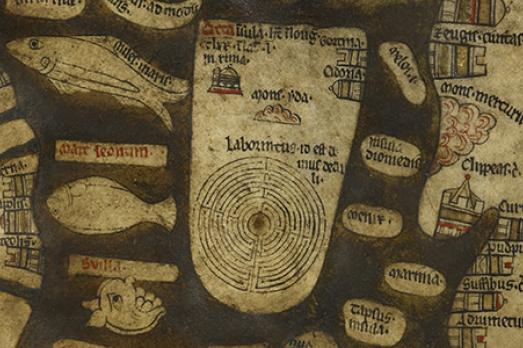The medieval cathedral was not monastic; the governing body, known as the Dean and Chapter, were not monks but secular priests who led active lives in the world. They employed the Vicars Choral, a body of clergy who lived a collegiate life in the Vicars’ Cloister, to sing the daily services for them.
In 794D Ethelbert, the young King of the East Angles, came to ask for the hand in marriage of the daughter of King Offa of Mercia. Ethelbert was murdered by order of the King or of his Queen and his remains were interred in Hereford Cathedral, which was already 200 years old. After his acclamation as a saint, the cathedral was dedicated to him jointly with the Blessed Virgin Mary. King Offa is famous for building the ditch (‘Offa’s Dyke’) to divide England from Wales.
The cathedral was rebuilt by Athelstan, 25th Bishop of Hereford, but in 1055 it was destroyed by a rebel Welsh army. Ethelbert’s shrine and many other treasures were lost. An 8th century illuminated Gospel Book, the Hereford Gospels, is the only artefact still at the cathedral to have survived, and is a precious spiritual treasure.
After the Norman Conquest of 1066, the cathedral was rebuilt in Norman or Romanesque style. Much of earlier Saxon structure remains, including sections of the crypt, chapel, nave, and south transept. By the 1190s Hereford Cathedral had become an important national centre of learning and scholarship, making the cathedral school one of the oldest in the country.
The treasures of the interior are many and varied. Around 1200–20 Bishop de Vere commissioned Hereford’s beautiful Limoges enamel reliquary to contain a relic of the murdered archbishop, St Thomas Becket.
Perhaps the most famous though is the Mappa Mundi. Made by Richard of Holdingham around 1300 it is the only complete world map of its kind. It is a fascinating pictorial encyclopaedia of the medieval world and is one of the cathedral’s greatest treasures and of international importance.
The cathedral also houses the Chained Library. Created in 1611 it is the largest of its kind in existence. In the Middle Ages books were so rare and valuable that they were often chained for safe keeping. The Chained Library is a rare example of this. Among the manuscripts on display is a copy of the original Magna Carta of 1215, and the illuminated 8th century manuscript known as the Hereford Gospels.








